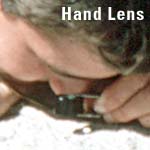- Adapted from COLLECTING ROCKS by Rachel M. Barker
Collecting Equipment
 The beginning collector needs two pieces of somewhat specialized equipment -- a geologist's hammer and a hand lens. The hammer is used to break off fresh rock specimens and to trim them to display size. It can be purchased through hardware stores or scientific supply houses. The head of a geologist's hammer has one blunt hammering end. The other end of the most versatile and widely used style is a pick. Another popular style -- the chisel type -- has one chisel end; it is used mostly in soft sedimentary rocks and in collecting fossils.
The beginning collector needs two pieces of somewhat specialized equipment -- a geologist's hammer and a hand lens. The hammer is used to break off fresh rock specimens and to trim them to display size. It can be purchased through hardware stores or scientific supply houses. The head of a geologist's hammer has one blunt hammering end. The other end of the most versatile and widely used style is a pick. Another popular style -- the chisel type -- has one chisel end; it is used mostly in soft sedimentary rocks and in collecting fossils.
The hand lens, sometimes called a pocket magnifier, is used to identify mineral grains. Hand lenses can be purchased in jewelry stores, optical shops, or scientific supply houses. Six-power to ten-power magnification is best. Optically uncorrected hand lenses are inexpensive and quite satisfactory, but the advanced collector will want an optically corrected lens.
 Other pieces of necessary equipment are inexpensive and easy to find: a knapsack to carry specimens, equipment, and food; bags and paper in which to wrap individual specimens; a notebook for keeping field notes until more permanent records can be made; and a pocket-knife, helpful in many ways, especially to test the hardness of mineral grains.
Other pieces of necessary equipment are inexpensive and easy to find: a knapsack to carry specimens, equipment, and food; bags and paper in which to wrap individual specimens; a notebook for keeping field notes until more permanent records can be made; and a pocket-knife, helpful in many ways, especially to test the hardness of mineral grains.
On some collecting trips, additional equipment is needed. Sledge hammers can be used to break especially hard ledges of rock. Cold chisels often make it possible to loosen specimens. Dilute hydrochloric acid helps in identifying limestone and dolomite. A long list could be made of such equipment; the collector must decide for each expedition which tools are really worth the weight.